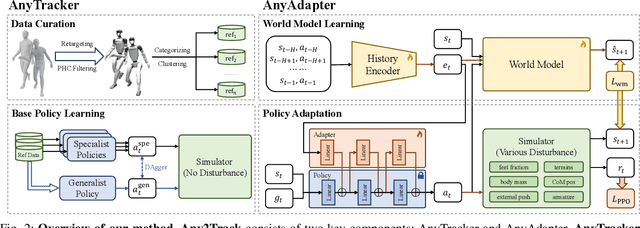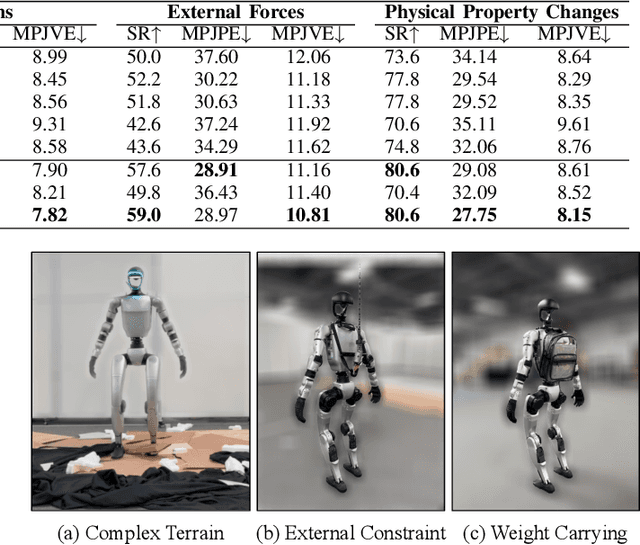Jun Guo
OneTrans: Unified Feature Interaction and Sequence Modeling with One Transformer in Industrial Recommender
Oct 30, 2025Abstract:In recommendation systems, scaling up feature-interaction modules (e.g., Wukong, RankMixer) or user-behavior sequence modules (e.g., LONGER) has achieved notable success. However, these efforts typically proceed on separate tracks, which not only hinders bidirectional information exchange but also prevents unified optimization and scaling. In this paper, we propose OneTrans, a unified Transformer backbone that simultaneously performs user-behavior sequence modeling and feature interaction. OneTrans employs a unified tokenizer to convert both sequential and non-sequential attributes into a single token sequence. The stacked OneTrans blocks share parameters across similar sequential tokens while assigning token-specific parameters to non-sequential tokens. Through causal attention and cross-request KV caching, OneTrans enables precomputation and caching of intermediate representations, significantly reducing computational costs during both training and inference. Experimental results on industrial-scale datasets demonstrate that OneTrans scales efficiently with increasing parameters, consistently outperforms strong baselines, and yields a 5.68% lift in per-user GMV in online A/B tests.
Track Any Motions under Any Disturbances
Sep 17, 2025



Abstract:A foundational humanoid motion tracker is expected to be able to track diverse, highly dynamic, and contact-rich motions. More importantly, it needs to operate stably in real-world scenarios against various dynamics disturbances, including terrains, external forces, and physical property changes for general practical use. To achieve this goal, we propose Any2Track (Track Any motions under Any disturbances), a two-stage RL framework to track various motions under multiple disturbances in the real world. Any2Track reformulates dynamics adaptability as an additional capability on top of basic action execution and consists of two key components: AnyTracker and AnyAdapter. AnyTracker is a general motion tracker with a series of careful designs to track various motions within a single policy. AnyAdapter is a history-informed adaptation module that endows the tracker with online dynamics adaptability to overcome the sim2real gap and multiple real-world disturbances. We deploy Any2Track on Unitree G1 hardware and achieve a successful sim2real transfer in a zero-shot manner. Any2Track performs exceptionally well in tracking various motions under multiple real-world disturbances.
Robustness Feature Adapter for Efficient Adversarial Training
Aug 25, 2025Abstract:Adversarial training (AT) with projected gradient descent is the most popular method to improve model robustness under adversarial attacks. However, computational overheads become prohibitively large when AT is applied to large backbone models. AT is also known to have the issue of robust overfitting. This paper contributes to solving both problems simultaneously towards building more trustworthy foundation models. In particular, we propose a new adapter-based approach for efficient AT directly in the feature space. We show that the proposed adapter-based approach can improve the inner-loop convergence quality by eliminating robust overfitting. As a result, it significantly increases computational efficiency and improves model accuracy by generalizing adversarial robustness to unseen attacks. We demonstrate the effectiveness of the new adapter-based approach in different backbone architectures and in AT at scale.
KG-Augmented Executable CoT for Mathematical Coding
Aug 06, 2025Abstract:In recent years, large language models (LLMs) have excelled in natural language processing tasks but face significant challenges in complex reasoning tasks such as mathematical reasoning and code generation. To address these limitations, we propose KG-Augmented Executable Chain-of-Thought (KGA-ECoT), a novel framework that enhances code generation through knowledge graphs and improves mathematical reasoning via executable code. KGA-ECoT decomposes problems into a Structured Task Graph, leverages efficient GraphRAG for precise knowledge retrieval from mathematical libraries, and generates verifiable code to ensure computational accuracy. Evaluations on multiple mathematical reasoning benchmarks demonstrate that KGA-ECoT significantly outperforms existing prompting methods, achieving absolute accuracy improvements ranging from several to over ten percentage points. Further analysis confirms the critical roles of GraphRAG in enhancing code quality and external code execution in ensuring precision. These findings collectively establish KGA-ECoT as a robust and highly generalizable framework for complex mathematical reasoning tasks.
Harnessing Caption Detailness for Data-Efficient Text-to-Image Generation
May 21, 2025Abstract:Training text-to-image (T2I) models with detailed captions can significantly improve their generation quality. Existing methods often rely on simplistic metrics like caption length to represent the detailness of the caption in the T2I training set. In this paper, we propose a new metric to estimate caption detailness based on two aspects: image coverage rate (ICR), which evaluates whether the caption covers all regions/objects in the image, and average object detailness (AOD), which quantifies the detailness of each object's description. Through experiments on the COCO dataset using ShareGPT4V captions, we demonstrate that T2I models trained on high-ICR and -AOD captions achieve superior performance on DPG and other benchmarks. Notably, our metric enables more effective data selection-training on only 20% of full data surpasses both full-dataset training and length-based selection method, improving alignment and reconstruction ability. These findings highlight the critical role of detail-aware metrics over length-based heuristics in caption selection for T2I tasks.
FlowDreamer: A RGB-D World Model with Flow-based Motion Representations for Robot Manipulation
May 15, 2025



Abstract:This paper investigates training better visual world models for robot manipulation, i.e., models that can predict future visual observations by conditioning on past frames and robot actions. Specifically, we consider world models that operate on RGB-D frames (RGB-D world models). As opposed to canonical approaches that handle dynamics prediction mostly implicitly and reconcile it with visual rendering in a single model, we introduce FlowDreamer, which adopts 3D scene flow as explicit motion representations. FlowDreamer first predicts 3D scene flow from past frame and action conditions with a U-Net, and then a diffusion model will predict the future frame utilizing the scene flow. FlowDreamer is trained end-to-end despite its modularized nature. We conduct experiments on 4 different benchmarks, covering both video prediction and visual planning tasks. The results demonstrate that FlowDreamer achieves better performance compared to other baseline RGB-D world models by 7% on semantic similarity, 11% on pixel quality, and 6% on success rate in various robot manipulation domains.
MFogHub: Bridging Multi-Regional and Multi-Satellite Data for Global Marine Fog Detection and Forecasting
May 15, 2025Abstract:Deep learning approaches for marine fog detection and forecasting have outperformed traditional methods, demonstrating significant scientific and practical importance. However, the limited availability of open-source datasets remains a major challenge. Existing datasets, often focused on a single region or satellite, restrict the ability to evaluate model performance across diverse conditions and hinder the exploration of intrinsic marine fog characteristics. To address these limitations, we introduce \textbf{MFogHub}, the first multi-regional and multi-satellite dataset to integrate annotated marine fog observations from 15 coastal fog-prone regions and six geostationary satellites, comprising over 68,000 high-resolution samples. By encompassing diverse regions and satellite perspectives, MFogHub facilitates rigorous evaluation of both detection and forecasting methods under varying conditions. Extensive experiments with 16 baseline models demonstrate that MFogHub can reveal generalization fluctuations due to regional and satellite discrepancy, while also serving as a valuable resource for the development of targeted and scalable fog prediction techniques. Through MFogHub, we aim to advance both the practical monitoring and scientific understanding of marine fog dynamics on a global scale. The dataset and code are at \href{https://github.com/kaka0910/MFogHub}{https://github.com/kaka0910/MFogHub}.
ConMo: Controllable Motion Disentanglement and Recomposition for Zero-Shot Motion Transfer
Apr 03, 2025Abstract:The development of Text-to-Video (T2V) generation has made motion transfer possible, enabling the control of video motion based on existing footage. However, current methods have two limitations: 1) struggle to handle multi-subjects videos, failing to transfer specific subject motion; 2) struggle to preserve the diversity and accuracy of motion as transferring to subjects with varying shapes. To overcome these, we introduce \textbf{ConMo}, a zero-shot framework that disentangle and recompose the motions of subjects and camera movements. ConMo isolates individual subject and background motion cues from complex trajectories in source videos using only subject masks, and reassembles them for target video generation. This approach enables more accurate motion control across diverse subjects and improves performance in multi-subject scenarios. Additionally, we propose soft guidance in the recomposition stage which controls the retention of original motion to adjust shape constraints, aiding subject shape adaptation and semantic transformation. Unlike previous methods, ConMo unlocks a wide range of applications, including subject size and position editing, subject removal, semantic modifications, and camera motion simulation. Extensive experiments demonstrate that ConMo significantly outperforms state-of-the-art methods in motion fidelity and semantic consistency. The code is available at https://github.com/Andyplus1/ConMo.
Neural Normalized Cut: A Differential and Generalizable Approach for Spectral Clustering
Mar 12, 2025Abstract:Spectral clustering, as a popular tool for data clustering, requires an eigen-decomposition step on a given affinity to obtain the spectral embedding. Nevertheless, such a step suffers from the lack of generalizability and scalability. Moreover, the obtained spectral embeddings can hardly provide a good approximation to the ground-truth partition and thus a k-means step is adopted to quantize the embedding. In this paper, we propose a simple yet effective scalable and generalizable approach, called Neural Normalized Cut (NeuNcut), to learn the clustering membership for spectral clustering directly. In NeuNcut, we properly reparameterize the unknown cluster membership via a neural network, and train the neural network via stochastic gradient descent with a properly relaxed normalized cut loss. As a result, our NeuNcut enjoys a desired generalization ability to directly infer clustering membership for out-of-sample unseen data and hence brings us an efficient way to handle clustering task with ultra large-scale data. We conduct extensive experiments on both synthetic data and benchmark datasets and experimental results validate the effectiveness and the superiority of our approach. Our code is available at: https://github.com/hewei98/NeuNcut.
Embodied VideoAgent: Persistent Memory from Egocentric Videos and Embodied Sensors Enables Dynamic Scene Understanding
Dec 31, 2024



Abstract:This paper investigates the problem of understanding dynamic 3D scenes from egocentric observations, a key challenge in robotics and embodied AI. Unlike prior studies that explored this as long-form video understanding and utilized egocentric video only, we instead propose an LLM-based agent, Embodied VideoAgent, which constructs scene memory from both egocentric video and embodied sensory inputs (e.g. depth and pose sensing). We further introduce a VLM-based approach to automatically update the memory when actions or activities over objects are perceived. Embodied VideoAgent attains significant advantages over counterparts in challenging reasoning and planning tasks in 3D scenes, achieving gains of 4.9% on Ego4D-VQ3D, 5.8% on OpenEQA, and 11.7% on EnvQA. We have also demonstrated its potential in various embodied AI tasks including generating embodied interactions and perception for robot manipulation. The code and demo will be made public.
 Add to Chrome
Add to Chrome Add to Firefox
Add to Firefox Add to Edge
Add to Edge